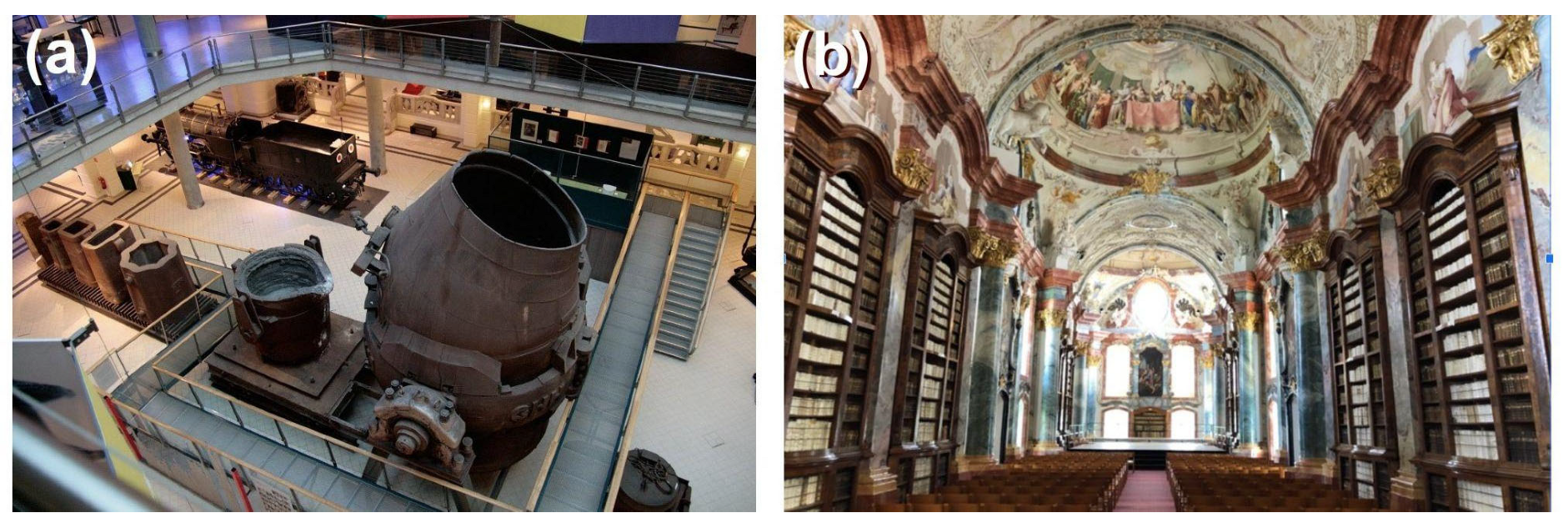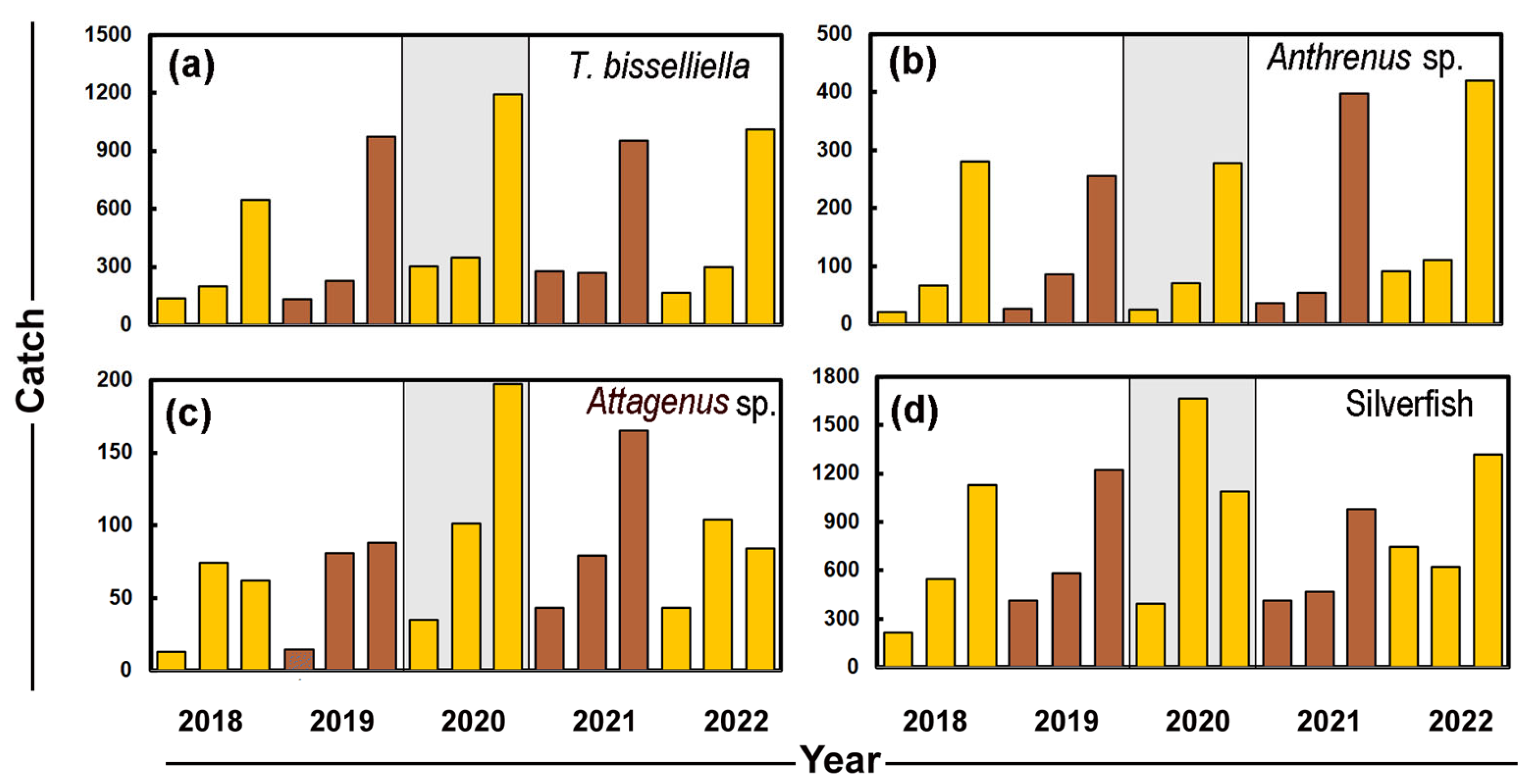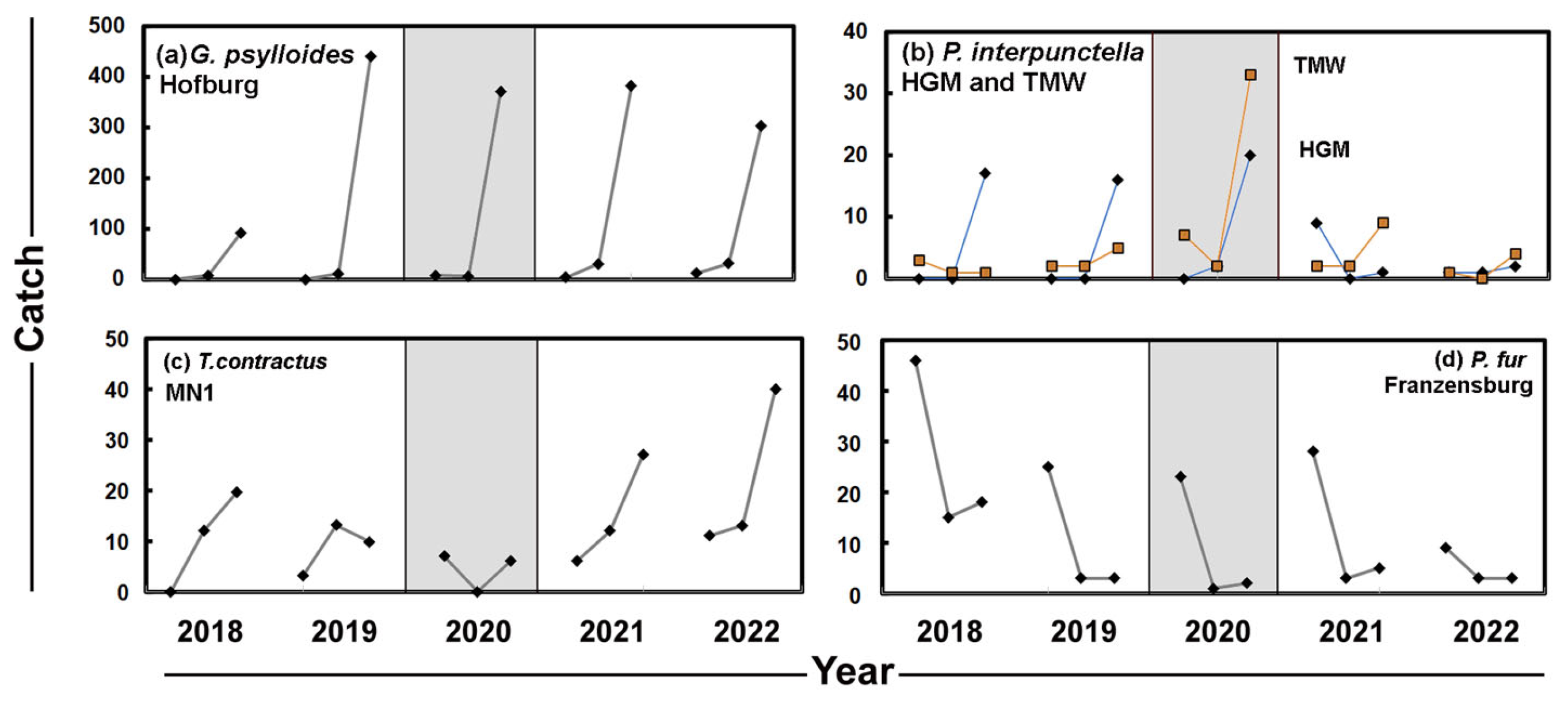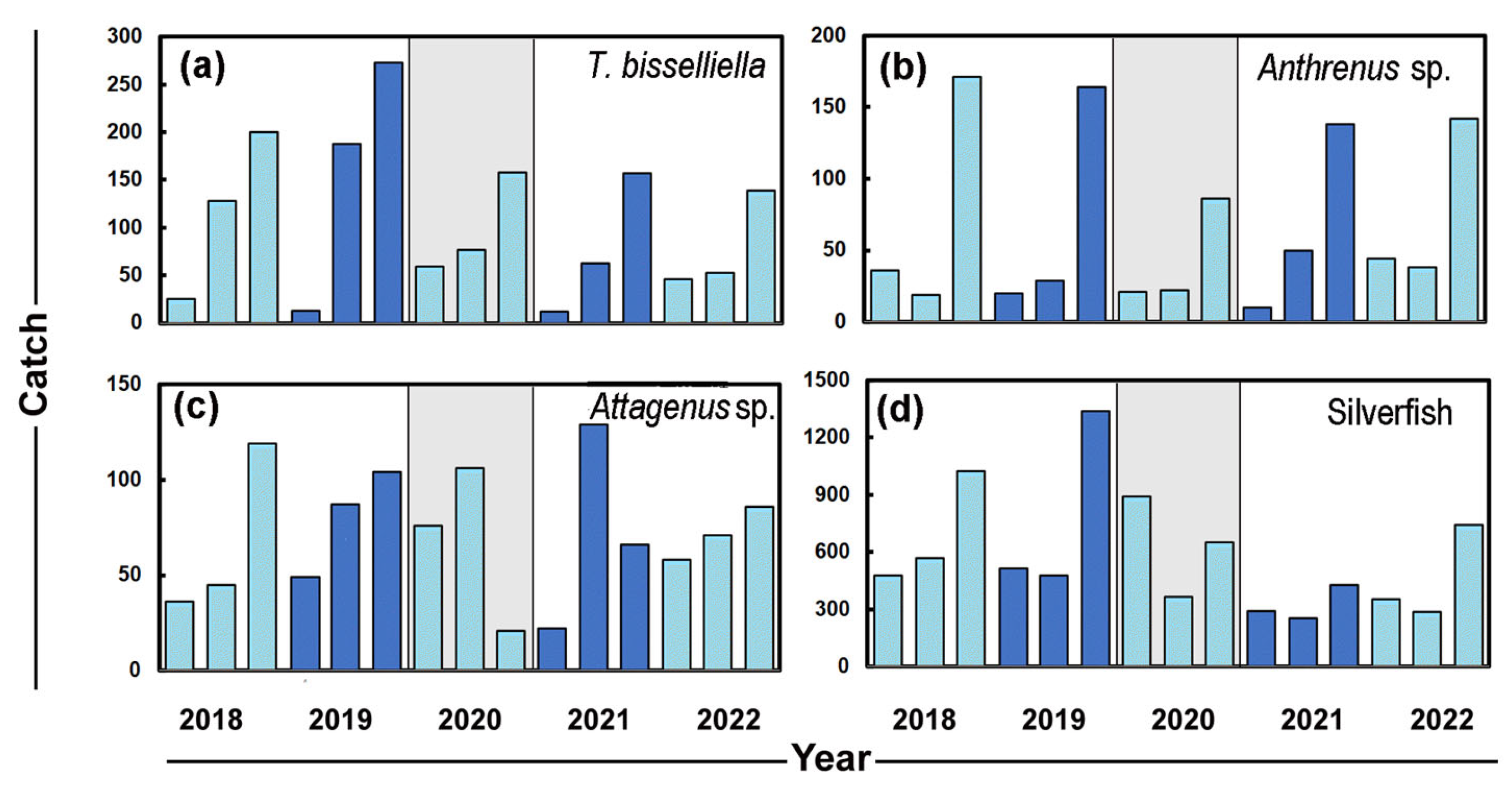Changing Insect Catch in Viennese Museums during COVID-19
Abstract
1. Introduction
2. Materials and Methods
2.1. Sites
2.2. Insects and Traps
2.3. Data Analysis
3. Results
3.1. Catch in Museum Galleries
3.2. Catch in Storage Areas
3.3. Catch during Closures
3.3.1. Lockdown I
3.3.2. Lockdown II
4. Discussion
5. Conclusions
Supplementary Materials
Author Contributions
Funding
Institutional Review Board Statement
Informed Consent Statement
Data Availability Statement
Conflicts of Interest
References
- United Nations Educational, Scientific and Cultural Organization. Museums Around the World in the Face of COVID-19; United Nations Educational, Scientific and Cultural Organization: Paris, France, 2020. [Google Scholar]
- ICOM. Museums, Museum Professionals and COVID-19: Survey Results; ICOM: Paris, France, 2020. [Google Scholar]
- Kramer, A.; Kramer, K.Z. The potential impact of the Covid-19 pandemic on occupational status, work from home, and occupational mobility. J. Vocat. Behav. 2020, 119, 103442. [Google Scholar] [CrossRef] [PubMed]
- Sun, Y.; Li, Y.; Bao, Y.; Meng, S.; Sun, Y.; Schumann, G.; Kosten, T.; Strang, J.; Lu, L.; Shi, J. Brief report: Increased addictive internet and substance use behavior during the COVID-19 pandemic in China. Am. J. Addict. 2020, 29, 268–270. [Google Scholar] [CrossRef] [PubMed]
- Ezani, E.; Brimblecombe, P.; Asha’ari, Z.H.; Fazil, A.A.; Ismail, S.N.; Ramly, Z.T.; Khan, M.F. Indoor and outdoor exposure to PM2. 5 during COVID-19 lockdown in suburban Malaysia. Aerosol. Air Qual. Res. 2021, 21, 200476. [Google Scholar] [CrossRef]
- Manenti, R.; Mori, E.; Di Canio, V.; Mercurio, S.; Picone, M.; Caffi, M.; Brambilla, M.; Ficetola, G.F.; Rubolini, D. The good, the bad and the ugly of COVID-19 lockdown effects on wildlife conservation: Insights from the first European locked down country. Biol. Conserv. 2020, 249, 108728. [Google Scholar] [CrossRef] [PubMed]
- Gordo, O.; Brotons, L.; Herrando, S.; Gargallo, G. Rapid behavioural response of urban birds to COVID-19 lockdown. Proc. Royal Soc. B 2021, 288, 20202513. [Google Scholar] [CrossRef]
- Network of European Museum Organisations. Survey on the Impact of the COVID-19 Situation on Museums in Europe; Network of European Museum Organisations: Berlin, Germany, 2020. [Google Scholar]
- Moon, S. Effects of COVID-19 on the Entertainment Industry. IDOSR-JES. 2020, 5, 8–12. [Google Scholar]
- King, E.; Smith, M.P.; Wilson, P.F.; Williams, M.A. Digital responses of UK museum exhibitions to the COVID-19 crisis, March–June 2020. Curator Mus. J. 2021, 64, 487–504. [Google Scholar] [CrossRef]
- Forrest, A. Exceptional Times, Extraordinary Discoveries: Lockdown at Oxburgh Hall. Curator’s Blog. 11 November 2020. Available online: https://www.nationaltrust.org.uk/blogs/curators-blog/exceptional-times-extraordinary-discoveries-lockdownat-oxburgh-hall (accessed on 14 October 2021).
- British Pest Control Association. Invasive Pest Fears for British Museum Due to COVID-19 Lockdown; British Pest Control Association: Derby, UK, 2020; Available online: https://bpca.org.uk/News-and-Blog/Pest-watch/invasive-pest-fears-for-british-museum-due-to-covid-lockdown/259073 (accessed on 1 January 2023).
- Brimblecombe, P.; Querner, P. Silverfish (Zygentoma) in Austrian museums before and during COVID-19 lockdown. Int. Biodeterior. Biodegradation. 2021, 164, 105296. [Google Scholar] [CrossRef]
- Brimblecombe, P.; Pachler, M.C.; Querner, P. Effect of Indoor Climate and Habitat Change on Museum Insects during COVID-19 Closures. Heritage 2021, 4, 3497–3506. [Google Scholar] [CrossRef]
- Brimblecombe, P.; Querner, P. Webbing clothes moth catch and the management of heritage environments. Int. Biodeterior. Biodegradation. 2014, 96, 50–57. [Google Scholar] [CrossRef]
- Cannon, R.J. The implications of predicted climate change for insect pests in the UK, with emphasis on non-indigenous species. Glob. Chang. Biol. 1998, 4, 785–796. [Google Scholar] [CrossRef]
- Brimblecombe, P.; Lankester, P. Long-term changes in climate and insect damage in historic houses. Stud. Conserv. 2013, 58, 13–22. [Google Scholar] [CrossRef]
- Brimblecombe, P.; Brimblecombe, C.T. Trends in insect catch at historic properties. J. Cult. Herit. 2015, 16, 127–133. [Google Scholar] [CrossRef]
- Querner, P.; Sterflinger, K.; Derksen, K.; Leissner, J.; Landsberger, B.; Hammer, A.; Brimblecombe, P. Climate Change and Its Effects on Indoor Pests (Insect and Fungi) in Museums. Climate 2022, 10, 103. [Google Scholar] [CrossRef]
- Biebl, S.; Querner, P. Transportation of wood boring beetles in wooden transport boxes, wooden pallets, and newly bought wood in museums. Stud. Conserv. 2021, 66, 44–50. [Google Scholar] [CrossRef]
- Pinniger, D.B. Ten years one from vodka beetles to risk zones. In Integrated Pest Management for Collections; Winsor, P., Pinniger, D., Bacon, L., Child, B., Harris, K., Lauder, D., Phippard, J., Xavier Rowe, A., Eds.; English Heritage: Swindon, UK, 2011; pp. 1–9. [Google Scholar]
- Aak, A.; Hage, M.; Magerøy, Ø.; Byrkjeland, R.; Lindstedt, H.H.; Ottesen, P.; Rukke, B.A. Introduction, dispersal, establishment and societal impact of the long-tailed silverfish Ctenolepisma longicaudata (Escherich, 1905) in Norway. BioInvasions Rec. 2021, 10, 483–498. [Google Scholar] [CrossRef]
- Querner, P.; Szucsich, N.; Landsberger, B.; Erlacher, S.; Trebicki, L.; Grabowski, M.; Brimblecombe, P. Identification and Spread of the Ghost Silverfish (Ctenolepisma calvum) among Museums and Homes in Europe. Insects 2022, 13, 855. [Google Scholar] [CrossRef]
- Hage, M.; Rukke, B.A.; Ottesen, P.S.; Widerøe, H.P.; Aak, A. First record of the four-lined silverfish, Ctenolepisma lineata (Fabricius, 1775) (Zygentoma, Lepismatidae), in Norway, with notes on other synanthropic lepismatids. Nor. J. Entomol. 2020, 67, 8–14. [Google Scholar]
- Querner, P. Linking webbing clothes moths to infested objects or other food sources in museums. Stud. Conserv. 2016, 61, 111–117. [Google Scholar] [CrossRef]
- Mohandass, S.; Arthur, F.H.; Zhu, K.Y.; Throne, J.E. Biology and management of Plodia interpunctella (Lepidoptera: Pyralidae) in stored products. J. Stored Prod. Res. 2007, 43, 302–311. [Google Scholar] [CrossRef]
- Hansen, L.S.; Åkerlund, M.; Grøntoft, T.; Ryhl-Svendsen, M.; Schmidt, A.L.; Bergh, J.-E.; Jensen, K.-M.V. Future pest status of an insect pest in museums, Attagenus smirnovi: Distribution and food consumption in relation to climate change. J. Cult. Herit. 2012, 13, 22–27. [Google Scholar] [CrossRef]
- Dove, C.J. Evaluation of an integrated pest management program, division of birds, US National Museum of Natural History. Collection. 1992, 11, 28–38. [Google Scholar]
- Howe, R.W.; Burges, H.D. Studies on beetles of the family ptinidae.* VI.—The biology of Ptinus fur (L.) and P. sexpunctatus Panzer. Entomol. 1951, 42, 499–511. [Google Scholar]
- Kulma, M.; Bubová, T.; Davies, M.P.; Boiocchi, F.; Patoka, J. Ctenolepisma longicaudatum Escherich (1905) became a common pest in europe: Case studies from Czechia and the United Kingdom. Insects 2021, 12, 810. [Google Scholar] [CrossRef] [PubMed]
- Sammet, K.; Martin, M.; Kesküla, T.; Kurina, O. An update to the distribution of invasive Ctenolepisma longicaudatum Escherich in northern Europe, with an overview of other records of Estonian synanthropic bristletails (Insecta: Zygentoma). Biodivers. Data J. 2021, 9, e61848. [Google Scholar] [CrossRef]
- Weidner, H.; Sellenschlo, U. Vorratsschädlinge und Hausungeziefer: Bestimmungstabellen für Mitteleuropa. 7. Auflage; Spektrum Akademischer Verlag: Heidelberg/Berlin, Germany, 2010. [Google Scholar]
- Mike’s Insect Keys. Key for the Identification of British Dermestidae. Available online: https://sites.google.com/view/mikes-insect-keys/mikes-insect-keys/keys-for-the-identification-of-british-beetles-coleoptera/key-for-the-identification-of-british-dermestidae (accessed on 20 February 2022).
- Háva, J. Beetles of the Family Dermestidae of the Czech and Slovak Republics; Academia: Praha, Czech Republic, 2021. [Google Scholar]
- Brimblecombe, P.; Sterflinger, K.; Derksen, K.; Haltrich, M.; Querner, P. Thermohygrometric climate, insects and fungi in the Klosterneuburg Monastic Library. Heritage 2022, 5, 4228–4244. [Google Scholar] [CrossRef]
- Bell, K.; Philips, T.K. Molecular systematics and evolution of the Ptinidae (Coleoptera: Bostrichoidea) and related families. Zool. J. Linn. Soc. 2012, 165, 88–108. [Google Scholar] [CrossRef]
- Coyner, B.S.; Estrada, R.A. Increased Pest Activity During Temporary Closure Caused by COVID-19. SPNHC Connect. Newsl. Sept. 2020, 34, 24–25. [Google Scholar]
- Pandey, J. COVID-19 Impacts on Biodiversity Science Collections: Survey Results Identify Concerns. 2020. Available online: https://bcon.aibs.org/2020/05/19/covid-19-impacts-on-biodiversity-science-collections/ (accessed on 20 February 2023).




| Museum | Site Code | Type | Age | Traps |
|---|---|---|---|---|
| 21er Haus | 21e | Museum | modern | 14 |
| Altenburg Library (LA) | Alt | Library | historic | 32 |
| Oberes Belvedere | BeO | Museum | historic | 70 |
| Unteres Belvedere | BeU | Museum | historic | 20 |
| Dom Museum | Dom | Museum | historic | 36 |
| Feuerwehr Museum | Feu | Museum | historic | 24 |
| Franzensburg (LA) | Fra | Castle | historic | 135 |
| Heeresgeschichtliches Museum | HGM | Museum | historic | 110 |
| Hofburg | HOF | Museum | historic | 122 |
| Museum 1 | MN1 | Museum | historic | 39 |
| Museum für angewandte Kunst | MAK | Museum | historic | 55 |
| Museum Niederösterreich (LA) | MNO | Museum | modern | 62 |
| Museum 2 | MN2 | Library | historic | 116 |
| Schönbrunn Palace | Sch | Palace | historic | 166 |
| Technisches Museum Wien | TMW | Museum | historic | 199 |
| Storage | ||||
| 21er Haus | X21 | Art store | modern | 81 |
| Belvedere-Oberes | XBO | Bunker | historic | 27 |
| Belvedere-Unteres | XBU | Cafe/study | historic | 40 |
| Feuerwehr Museum | XFe | Archive/depots | historic | 19 |
| Heeresgeschichtliches Museum | XHG | Store | historic | 207 |
| Museum für angewandte Kunst | XMA | Three depots | historic | 94 |
| Museum Niederösterreich (LA) | XMN | Depots | modern | 159 |
| Museum 2 | XN2 | Manuscripts | historic | 70 |
| Schönbrunn Palace | XSc | Depots | historic | 160 |
| Technisches Museum Wien | XTM | Archive | historic | 59 |
| Code | Tine. | Anth. | Atta. | Zyge. | Gibb. | Plod. | Thyl. | Ptin. | Steg. |
|---|---|---|---|---|---|---|---|---|---|
| 21e | 165 | 51 | 6 | 316 | 0 | 0 | 0 | 0 | 2 |
| Alt | 22 | 70 | 23 | 104 | 1 | 8 | 0 | 5 | 5 |
| BeO | 1067 | 140 | 103 | 1783 | 0 | 7 | 0 | 8 | 3 |
| BeU | 321 | 55 | 10 | 132 | 0 | 2 | 0 | 1 | 0 |
| Dom | 28 | 21 | 33 | 282 | 1 | 1 | 0 | 0 | 1 |
| Feu | 101 | 29 | 8 | 488 | 0 | 2 | 0 | 0 | 0 |
| Fra | 27 | 258 | 131 | 174 | 0 | 38 | 0 | 162 | 5 |
| HGM | 1354 | 168 | 89 | 809 | 0 | 69 | 0 | 1 | 16 |
| HOF | 286 | 194 | 282 | 1108 | 1608 | 6 | 1 | 5 | 18 |
| MN1 | 32 | 19 | 17 | 141 | 0 | 0 | 150 | 0 | 0 |
| MAK | 33 | 71 | 89 | 749 | 0 | 1 | 0 | 0 | 2 |
| MN2 | 509 | 15 | 2 | 1043 | 0 | 2 | 0 | 3 | 1 |
| ÖN2 | 87 | 140 | 81 | 136 | 38 | 2 | 0 | 0 | 19 |
| Sch | 565 | 489 | 172 | 1551 | 0 | 0 | 0 | 25 | 14 |
| TMW | 2598 | 77 | 153 | 2833 | 0 | 74 | 0 | 1 | 2 |
| X21 | 2 | 1 | 1 | 1089 | 0 | 1 | 0 | 0 | 0 |
| XBO | 1 | 1 | 0 | 52 | 0 | 13 | 0 | 0 | 1 |
| XBU | 24 | 22 | 4 | 412 | 36 | 56 | 0 | 0 | 0 |
| XFe | 23 | 1 | 0 | 406 | 0 | 0 | 0 | 0 | 0 |
| XHG | 796 | 326 | 23 | 738 | 0 | 126 | 0 | 1 | 31 |
| XMA | 6 | 61 | 3 | 587 | 0 | 1 | 0 | 0 | 0 |
| XMN | 132 | 7 | 1 | 3028 | 0 | 2 | 0 | 3 | 0 |
| XON | 16 | 91 | 43 | 804 | 0 | 2 | 0 | 1 | 1 |
| XSc | 484 | 272 | 4 | 779 | 0 | 47 | 0 | 26 | 6 |
| XTM | 108 | 49 | 7 | 495 | 0 | 7 | 0 | 9 | 5 |
Disclaimer/Publisher’s Note: The statements, opinions and data contained in all publications are solely those of the individual author(s) and contributor(s) and not of MDPI and/or the editor(s). MDPI and/or the editor(s) disclaim responsibility for any injury to people or property resulting from any ideas, methods, instructions or products referred to in the content. |
© 2023 by the authors. Licensee MDPI, Basel, Switzerland. This article is an open access article distributed under the terms and conditions of the Creative Commons Attribution (CC BY) license (https://creativecommons.org/licenses/by/4.0/).
Share and Cite
Brimblecombe, P.; Querner, P. Changing Insect Catch in Viennese Museums during COVID-19. Heritage 2023, 6, 2809-2821. https://doi.org/10.3390/heritage6030150
Brimblecombe P, Querner P. Changing Insect Catch in Viennese Museums during COVID-19. Heritage. 2023; 6(3):2809-2821. https://doi.org/10.3390/heritage6030150
Chicago/Turabian StyleBrimblecombe, Peter, and Pascal Querner. 2023. "Changing Insect Catch in Viennese Museums during COVID-19" Heritage 6, no. 3: 2809-2821. https://doi.org/10.3390/heritage6030150
APA StyleBrimblecombe, P., & Querner, P. (2023). Changing Insect Catch in Viennese Museums during COVID-19. Heritage, 6(3), 2809-2821. https://doi.org/10.3390/heritage6030150








